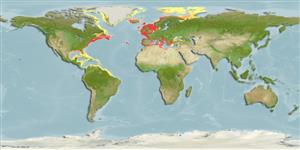Common names from other countries
Environment: milieu / climate zone / depth range / distribution range
Sinh thái học
; Mức độ sâu 25 - 200 m (Ref. 2754). Subtropical; 68°N - 9°N, 89°W - 44°E
Western Central and Northeast Atlantic, Mediterranean and Black Sea.
Length at first maturity / Bộ gần gũi / Khối lượng (Trọng lượng) / Age
Maturity: Lm ? range ? - ? cm Max length : 6.0 cm SHL con đực/không giới tính; (Ref. 2758)
Depth based on occurrence (Ref. 2758, p. 805); to be replaced with better reference. Minimum depth from Ref. 2758. Epifaunal, filter feeder (Ref. 96488). This is an attached species (Ref. 3123). Usually under stones (Ref. 107900) and widely distributed over crustose corallines (Ref. 113571).
Life cycle and mating behavior
Chín muồi sinh dục | Sự tái sinh sản | Đẻ trứng | Các trứng | Sự sinh sản | Ấu trùng
Members of the class Bivalvia are mostly gonochoric, some are protandric hermaphrodites. Life cycle: Embryos develop into free-swimming trocophore larvae, succeeded by the bivalve veliger, resembling a miniature clam.
Demir, M. 2003. (Ref. 2754)
IUCN Red List Status (Ref. 130435)
CITES status (Ref. 108899)
Not Evaluated
Not Evaluated
Human uses
| FishSource |
Các công cụ
Các nguồn internet
Estimates based on models
Preferred temperature
(Ref.
115969): 6.7 - 15.2, mean 9.8 (based on 409 cells).
Vulnerability
Low vulnerability (10 of 100).
Price category
Unknown.
